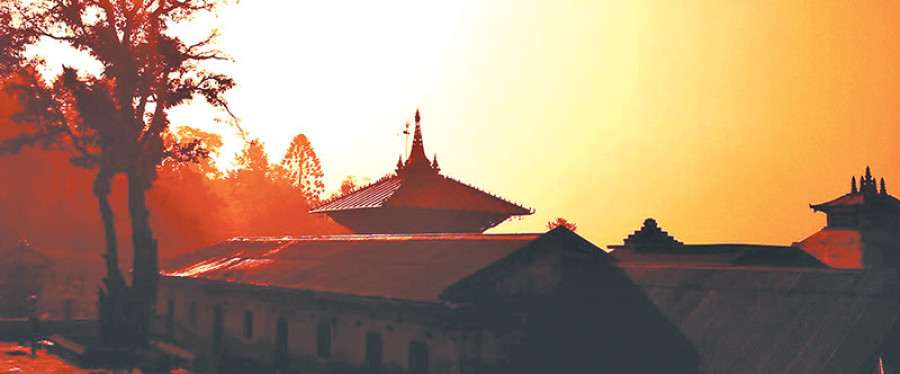Miscellaneous
Part of the art
Public display of affection is still frowned upon in Nepal and South Asia. Nepal Police still routinely harass couples enjoying their privacy in the quiet of hotel rooms, LGBT rights have been secured but sexuality is not yet open for public discussion. Chapters on human reproductive organs, as mandated by the government curriculum, are glossed over by teachers in schools, while sex education for young adults is either avoided or entirely dismissed by parents.
Sandesh Ghimire
Public display of affection is still frowned upon in Nepal and South Asia. Nepal Police still routinely harass couples enjoying their privacy in the quiet of hotel rooms, LGBT rights have been secured but sexuality is not yet open for public discussion. Chapters on human reproductive organs, as mandated by the government curriculum, are glossed over by teachers in schools, while sex education for young adults is either avoided or entirely dismissed by parents.
This modern prudishness and intolerance of sexual expressions easily fascinates and confuses those who encounter erotic art in struts, the outer angular column that supports temple structures in the Kathmandu Valley. “These innumerable variations in erotic imagery and their nonchalant dismissal of present day taboos; women with multiple men, men with men, men with animals, animals with animals, and even spirits with mortals,” writes Shivaji Das in his book, Sacred Love: Erotic Temple Arts of Nepal, implies the existence of a sexually liberated society prior to incursions from Muslim invaders and later from the British. This particular interpretation served as an “essential catalyst for the Hippie era.” Historical knowledge such as that of the practice of Sati, where a widow immolates herself on her husband’s pyre, discredits the notion that erotic temple art accurately reflects the social reality of medieval times. The existence of such customs as well sources such as historical documents seem to suggest that while the temple reliefs might reflect the broad-minded reality of a certain point in time, this reality was probably in the process of change even before foreign incursions.
Some of the images, such as a “dwarf holding up a bowl to collect the semen underneath a copulating couple” in Pashupatinath Temple is considered so vulgar that even a priest denounced it—even though it is an ancient and once sacred relief that has always been part of the temple complex. So, naturally questions such as “Why were they there? And what did they symbolise?” drives the textual component of the book, which is interlaced with photographs of the erotic art found in Kathmandu’s temples.
Tracing the historical origins of the temples, Das reasons that there cannot have been one particular reason for carving sexual imagery below images of deities. Throughout the ages it seems, many purposes for the erotic carvings seems to have been retrofitted, and for different groups the carvings provided different meanings. “The woodcarvers, typically gave three possible reasons, architects gave five, and scholars wished they had more fingers to count,” Das writes. “There are as many conjectures as there are erotic carvings and except for the tour guides, no one is certain about their purpose.” Das goes on to list these probable purposes.

Either, the carvings are there to protect the temples from the goddess of lighting, because the goddess, the tourist guides will reason, is a virgin and will shy away from sexual depictions. Or the carvings were there, a sociologist might attempt to explain, “to promote Hinduism which was losing popularity to Buddhism during the Middle Ages, by projecting a cooler and worldly image of Hinduism in contrast to the austere monastic aspect of Buddhism.” And there are many other probable purposes that Das has renumerated in the book. It could simply be a more concentrated passion of an universal instinct, as Das puts it: “After all, given a pen and a chance, who wouldn’t want to scribble an erotic graffiti in a public space.”
Ultimately, all these purposes point to the convergence of many cultural practices that gave rise to monuments that “deserve a place in the hall of fame of mankind’s artistic achievement.” While the erotic art continue to be shrouded in mysticism, they continue to enchant viewers. However, as the state of affairs stand, woodcarving has become a profession in decline and restoration work has been very slow and severely hampered by the 2015 earthquakes.
These temples and the erotic art carved on them have significant economic importance as they are an intriguing subject to tourists, but more than that, these are testaments to the past and in recent times, these erotic temple carvings have even become a symbol of sexual liberation. With this in mind, the writer effectively creates a case for why the country and its people should invest in preserving its heritage, erotic or not.
Das’ writings complement the photographs in providing a survey on the subject matter.
The book is a wonderful confluence of scholarly investigation, interviews and observations. However, the scope of the book is limited to being a cursory study of erotic art. The book should be read as what it is: A wonderful essay by an enthusiast of Nepali art. My only criticism would be that Sacred Love could have gone a step further in its research to ensure scholarly depth while maintaining the easy prose of the book which is great for relaying the topic to new audiences.
The writer tweets @nepalichimney




 12.12°C Kathmandu
12.12°C Kathmandu










